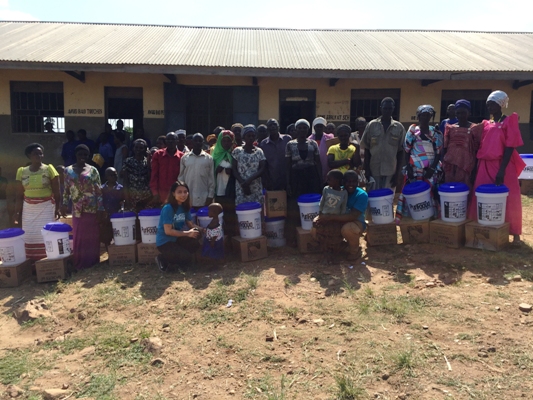Malaria remains a leading cause of illness and death in Uganda. Most of the country’s 43 million population is at risk. And the disease accounts for between a third and half
of all outpatient consultations. Each malaria episode costs a family on average 9 US dollars.
Even though Uganda had the 2nd largest reduction in malaria cases (1.5 million) between 2017 and 2018, Uganda is still the 3rd highest contributor of malaria cases and the 7th highest contributor of malaria deaths according to the 2019 WHO’s World Malaria Report. Furthermore, malaria has a significant negative impact on the economy of Uganda due to decreased productivity, lower school attendance and performance, and reduced foreign investments.
Political commitment to fight malaria is reflected in the Government’s manifesto of 2016 which listed malaria as one of the diseases targeted for elimination. At the highest level, H.E. President of Uganda is an active member of the African Leaders Malaria Alliance and has personally signed and launched the Mass Action Against Malaria (MAAM) to drive the country’s elimination agenda. Furthermore, a Parliamentary Forum for Malaria was formed with the Right Honourable Speaker of Parliament as its patron. The Government has abolished user fees in 2001 to guarantee free treatment in all public facilities and waived government taxes insecticide-treated nets (ITNs), malaria medicines and laboratory supplies.
In recent years, malaria prevalence, incidence and mortality have all declined steeply. However, this fell short of the targets from the Uganda Malaria Reduction Strategic Plan 2014-2020. Despite efforts, the Uganda Ministry of Health reported an increase in malaria cases from about 1 million cases in June 2018 to 1.4 million in June 2019. The upsurge affected about half the country with approximately 65 districts involved. The affected regions included: West Nile, Acholi, Lango, Busoga, Bunyoro, Buganda, Karamoja, Teso, Eastern and Western Uganda.
It is now observed that accurate diagnosis of malaria infection is critical for effective management and reduction of malaria transmission. While rapid diagnostic tests (RDTs) can confirm the presence of infection, currently available RDTs have limitations including their poor performance with low-level infections. Detecting these low-level infections becomes critical as the malaria burden decreases to fully eliminate parasite reservoirs.
There is also a need to increase case detection and treat all asymptomatic reservoirs at all levels. For that purpose, a new generation of highly sensitive rapid diagnostic tests (HS-RDTs) has been developed by Abbott with a significantly lower limit of detection (LOD) of parasites. The first of these is the ultra- sensitive NxTek™ Eliminate Malaria P.f (formerly known as the Alere™ Malaria Ag P.f). This test has a tenfold improvement in LOD of HRP2 protein (produced by the parasites), from 800 pg/mL to 80 pg/ml.
The results of this study indicate a significant increase in sensitivity for Pf (Plasmodium falciparum, the parasite causing the deadliest form of malaria) detection in low-density, sub-clinical infections with HS-RDTs. compared to conventional RDTs (cRDTs). The HS-RDT is highly promising and has received WHO pre-qualification as an effective diagnostic tool. This tool is being evaluated as an elimination tool to inform malaria elimination strategies.
For use with the HS-RDT,Abbott has introduced another innovation, the Data Logger Smartphone App (SMAPP), to support enhanced case detection and surveillance systems. This allows the healthcare worker to log a visually read RDT test result, as well as patient demographics, and transmit them securely together with the GPS location and the time of the test to the Uganda National Health Laboratory Services server. The system displays geospatial tests information on a map and enables health program managers to see data in near real-time. The Smartphone Data Logger app also enables the user to view information on the tests they performed, the patients and their results. This empowers healthcare workers and managers to utilize real-time data for evidence-based decision-making, quality services, and improved disease management.
The combination of HS-RDTs and the Data Logger SMAPP provides an opportunity for real-time disease surveillance and elimination interventions. This allows the MoH to implement strategies such as test and treat, index case finding, and identification of disease hotspots. The simplicity of the two technologies allows for utilization of integrated community case management (ICCM) service providers to play the leading role in implementing malaria elimination strategies, with real-time technical oversight.
In 2019, a project was designed to evaluate the feasibility of healthcare workers and ICCM service providers using HS-RDTs and the Data Logger Smartphone App (SMAPP) to identify malaria infections at health facilities and at the community level for targeted treatment. This purpose of the project was to inform accelerated disease control strategies and provide insight towards malaria elimination in Uganda. Identifying tools that can accelerate progress would be of great importance to the Ugandan malaria elimination programme, as well as to the larger community. If the HS-RDT is shown to be superior to the cRDT, then it paves the way for their potential adoption into routine use at health facilities and communities throughout Uganda.
Findings from the study indicated the following:
In the outpatient group (OPD), the parasite positivity rate was 13.3% for HS-RDTs, more than double that of 6.4% with cRDTs on the same patients., A large percentage of these was from school-age children and adolescents (5-17 years).
In the antenatal care group (ANC), 11% (384/3490) of the pregnant women were positive with malaria parasites despite existing prophylactic measures provided during pregnancy (intermittent preventive treatment and insecticide-treated bed nets). HS-RDTs again detected most of these positive cases (10.4%), much more than cRDTs (7.0%).
In the community setting, 79.7% (2,397/3,009) of children under-five years tested positive with malaria parasites. These 2,397 children led to the testing of 8,888 asymptomatic people in their households with HS-RDTs. From these family members, 21.1% (1,877) were positive.
Health workers from different backgrounds and with training levels were able to learn how to effectively perform the HS-RDT tests and use the Data Logger technology.
This study demonstrated the ability to of HS-RDT to detect asymptomatic cases and increase case findings of low-parasite density infections. This provides more opportunities to eliminate parasite reservoirs.
Increased sensitivity as demonstrated by HS-RDTs was at an acceptable level of accuracy (sensitivity, specificity and positive predictive value) when a subset was compared to PCR.
Real-time data reporting facilitated quick decision-making thanks to the Data Logger.
Findings from this study will further accelerate efforts toward the Uganda Malaria Reduction and Elimination Plan (UMREP) 2021 – 2025.





